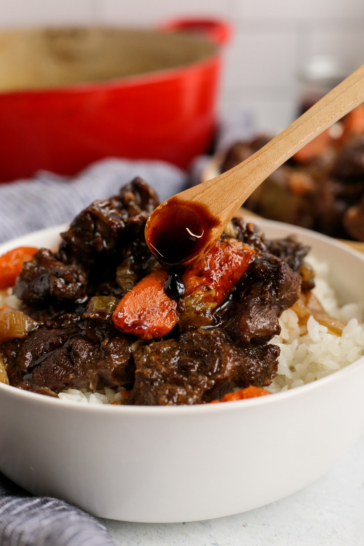Welcome to a four-part series written in partnership with the Missouri Beef Industry Council! This series will explore beef nutrition, beef’s role in sustainability, how cattle are raised for beef, and delicious ways to enjoy beef in your home kitchen. In Part Two, we take a closer look at the facts about beef sustainability.
I’m back for another installment in the blog series with the Missouri Beef Industry Council (MBIC). This time, I’m here to share more about beef sustainability in the second post in my “Meat of the Matter” series. Head over to Part 1 to learn about beef nutrition, then look for Part 3 and Part 4 coming soon!
What is Sustainable Beef?
Before we go any further, let’s define what we mean when talking about “sustainable” beef. Just like the word “natural” can hold different meanings for different people in different contexts, the word “sustainable” can be somewhat confusing.
I think of sustainability as a three-legged stool, with the three legs representing environmental sustainability, financial sustainability, and social sustainability. This visual is loosely based on reports and graphics developed by the Environmental Protection Agency (EPA). All too often, our idea of what is “sustainable” is confined to only what impacts the environment. However, we can’t forget that financial and social factors must also be included in the complex and interconnected systems that strive for true sustainability.

Here, we can see that on an individual farm or ranch, the three goals of environmental conservation, economic profitability, and social responsibility must work in tandem to support the farm or ranch. However, in a broader system, the three goals look more like overlapping circles. Without a healthy environment, neither society nor the economy can thrive.
When it comes to beef production, ranchers and beef producers are leading the charge to minimize negative impacts on the environment while also committing to financial and social sustainability. Since most of the questions I get from friends, family, and clients focus on the environmental impact, this post will focus on that dimension of beef sustainability.
Let’s break down some of the biggest questions about producing beef in a sustainable way, starting with the life cycle of beef cattle.
Overview of Beef Production
Beef has a long history in the United States and played a pivotal role in the history of Kansas City, where I currently live. In fact, Kansas City’s nickname is “Cow Town” and the neighborhood I live in is called the “Stockyards District”, so it’s clear cattle ranching has left its mark around here.
In the early days, cattle ranching was highly inefficient, with herds of cattle grazing across huge areas of land. They moved based on where the best grazing could be found, then transferred via railroad to be processed. It wasn’t ideal for animal health (which I’ll share more about in Part 3) and it wasn’t ideal for sustainability, either.
Cattle feedyards were developed in the 1850s by cotton mill owners. They were looking for a way to use cottonseed oil, one of the byproducts, and efficiency in feeding cattle for beef began to improve. Quality and safety also improved, and soon a more sophisticated system came to be.
Today, all beef cattle, regardless of whether they are grass-finished or grain-finished, follow a similar process outlined in the graphic below. Whether beef ranchers take on the role of a cow-calf operation, stocker/backgrounder, feedyard, or all of the above, they are able to adjust their practices as needed to do what’s best for the animals and the land.

Beef and the Environment
Although there is a growing interest in plant-based diets to combat climate change and live more sustainably, the reality is that animal agriculture does not contribute to the same degree as other industries, such as transportation, textiles, and travel.
I’m passionate about sharing this with you because I believe wholeheartedly in making informed and empowered decisions when it comes to eating. In order to do that, I think it’s essential to have the correct information in hand. Much of what we hear about beef’s impact on the environment is misleading – in reality, beef cattle can actually play a role in combatting climate change.
Here’s what I mean by that, based on sessions and discussions with Dr. Frank Mitloehner, a leading expert in air quality, agricultural efficiencies, and sustainability. He is a professor in the Department of Animal Science at the University of California, Davis, where he researches the relationship between animal agriculture and the environment. He was interviewed by fellow dietitian Melissa Joy Dobbins on her podcast, “Sound Bites” and had this to say:
“Methane is a potent greenhouse gas, but it is short-lived – it has a lifespan of approximately 10 years – and it’s not just produced, it’s also destroyed by a process called oxidation. The production and destruction of methane are almost in balance and unfortunately, the latter is always left out of the discussion and that is why beef and dairy look so bad in the media day in and day out.”
He went on to add:
“The problem is that this sends us on the wrong path to solutions – it suggests to people that what we have to worry about is what we eat and relax about everything else. That is irresponsible and incorrect.”
To see why it’s incorrect, we need to take a closer look at the issue of greenhouse gas (GHG) emissions.
How does beef impact GHG emissions?
Beef plays a far smaller role in contributing to overall GHG emissions than I previously believed. I once subscribed to the idea that cattle and their methane burps were a leading cause of increasing emissions, and therefore a significant contributor to climate change.
Side note: Contrary to popular belief, it’s not cow farts that are the problem because the majority of gases expelled by ruminants, including cattle, comes out of their mouths.
In reality, the animal agriculture sector in the United States (which includes all animals, including beef cattle) make up a very small percentage of GHG emissions: only 3.9%, according to the Environmental Protection Agency (EPA).
This is a stark contrast to the number we frequently hear in the media, which is often in the double-digits. One number often cited is 14.5%, but that refers to global GHG emissions from animal agriculture. Thanks in large part to the research on agriculture and the environment and hard work from American cattle ranchers, beef cattle production makes up a smaller piece of the pie for total emissions. When compared to other densely populated countries, such as Brazil, India, China, and some European nations, American livestock ranks much lower on the list of GHG emissions.
What’s the bottom line on cattle on the environment?
Beef is not the only food with an environmental footprint. The farmers I’ve talked with, such as cattle rancher Brandi Buzzard-Frobose (whose insights contributed greatly to this post) share their perspectives on how beef plays an important role in leading sustainability efforts because of its popularity. It’s a food in high demand, so there is a deep desire to continue producing beef to provide great taste and nutrition, as well as be mindful of the impact on land, water, soil, and air. Beef farmers and ranchers are dedicated to this cause and work daily to lessen those impacts by using the available resources responsibly and efficiently.
Benefits of Sustainably Produced Beef
When beef farmers and ranchers are able to adopt practices that serve both their operation and the environment, there are multiple tangible benefits.
Cattle are upcyclers, which refers to their ability to take inputs, such as grasses or byproducts from other industries, and convert them to a higher quality product. In the case of beef, products such a dried distillers grains, waste from the produce industry (“ugly” fruits and vegetables, carrot tops, beet pulp, and even grape skins from wine production), and grasses unfit from human consumption like fescue and brome can feed cattle. This means there is less food waste going into landfills.

Grass preservation and soil conservation are essential to maintaining a healthy herd and healthy pastures. Rotational grazing, or strategically and selectively moving the herd from one location to another, prevents overgrazing that leads to root damage. It also allows ranchers to test the soil for nutrients and use a customized weed-prevention plan. The herbicides used are regulated, monitored, and applied with caution to ensure runoff doesn’t enter water sources. Each operation faces different challenges with this, so there is no one-size-fits-all approach, but ranchers can adjust their targeted efforts.
Think of it as a Goldilocks strategy – you don’t want to apply too much, as that would be wasteful and potentially hazardous for humans, animals, and the environment. But you also don’t want to apply too little, as it might be ineffective and force you to respray or contend with poor quality grazing. You want to get it just right, and that’s exactly why ranches spend so much time focused on the way they manage their land.
Cattle are able to graze in areas that would otherwise be unable to produce food for human consumption. As nice as it would be to grow acre upon acre of fresh produce, some climates and soil types are simply unable to support that. Instead, these areas can serve as pasture land for beef cattle while also preserving habitats for wildlife such as deer, fox, raccoons, and many species of birds and small mammals. Pollinators and native plant species also show up in these pastures, allowing for greater biodiversity.
What is the future of sustainable beef?
With significant improvements in genetics, technology, and other advances across the agriculture industry, beef continues to become more efficient while remaining affordable and easily accessible in most grocery stores. Over the past several decades, the total herd size (total number of cattle) has decreased, while the total amount of available beef for consumption has increased.

Currently, only 2% of all Americans work directly in the agriculture industry. With fewer cattle ranchers and beef producers, efficiency in all areas of sustainability (environmental, financial, and social) will be necessary to supply enough beef to meet current demand. My conversations with farmers and personal experiences on farms and ranches instill a lot of faith that they are continuously striving to make even more improvements in these areas.
Beef is a nourishing and delicious food – you can read more about beef nutrition in Part 1 of this series – and I love using it in recipes no matter the season. Although I’m a passionate advocate for intuitive eating and a non-diet approach, I also recognize there are many factors that go into your decision to purchase, cook, and eat the foods you prefer. My hope is that this introduction to beef sustainability helps you feel more confident that your food choices are aligned with your values, especially if you value food choices that support healthy people, healthy animals, and a healthy planet.
If you want to see some other examples of how farmers and ranchers are tackling sustainability issues, check out these posts:
Special thanks to Brandi Buzzard Frobose, the Missouri Beef Industry Council, and Dr. Frank Mitloehner for their contributions to this post. Their insights are valued and appreciated!













